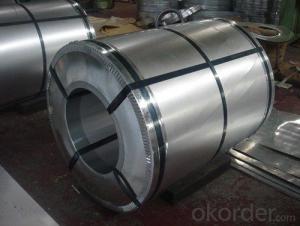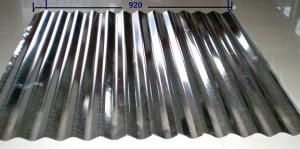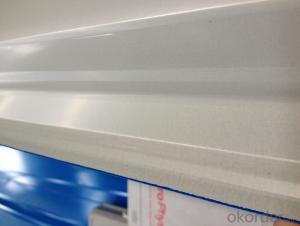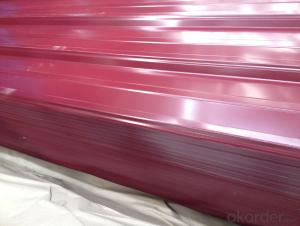HOT ALUZINC STEEL COIL
- Loading Port:
- China Main Port
- Payment Terms:
- TT OR LC
- Min Order Qty:
- -
- Supply Capability:
- -
OKorder Service Pledge
OKorder Financial Service
You Might Also Like
HOT-DIP GALVANIZED STEEL 72104910
THICKNESS:0.18mm-1.5mm
WIDTH:900mm-1250mm
COATING MASS:Z30-Z275
SPANGLE:Regular Spangle,Minimized Spangle,Zero Spangle
SURFACE TREATMENT:N0on or Chromated,Non or Oiled,Non or Anti Finger Print
COIL INNER DIAMETER:508mm/610mm
COIL WEIGHT:3mt-7mt
In continuous units in cold rolled steel strip, galvanized steel (electro galvanized and hot dip galvanized) as substrate, after surface pretreatment (degreasing and science processing), using the method of roll coating, coated with a layer or multi-layer liquid coating of plate, after baking and cooling income is the coating steel plate. Because the coating can have a variety of colors, on the habits of the coated steel sheet is called color coating steel plate. Because the coating is carried out before the sheet metal forming, in foreign countries which is called pre coating plate.
Color coated steel sheet is an organic coating coating on the steel surface, it has the advantages of beautiful appearance, bright color, high strength, good corrosion resistance, easy processing molding, but also allows the user to reduce costs, reduce pollution.
From the United States in 1935 to establish the first continuously coated steel line to begin, color coated steel plate has been widely applied, the current color coated plate varieties, about more than 600 kinds, the advantages of color coated sheet and organic polymer and steel plate of the two, which has good colorability, organic polymer molding, corrosion resistance and decorative, and steel plate with high strength and easy processing, can easily be punching cutting, bending, deep drawing processing. Made this makes organic coated steel sheet products have excellent practical, decorative, workability, durability.
- Q: Are the steel sheets suitable for agricultural applications?
- Steel sheets are indeed suitable for agricultural applications. This is because steel is an adaptable and enduring material that can endure harsh weather conditions and offer long-term structural support. In agriculture, steel sheets can be utilized in numerous ways. They can be employed to construct farm buildings, barns, sheds, and storage facilities. Furthermore, they can be utilized for fencing, roofing, and siding. The strength and resistance to pests, fire, and rot that steel sheets provide make them perfect for safeguarding agricultural equipment and crops. Moreover, steel is recyclable, making it an environmentally-friendly choice for sustainable farming practices. All in all, steel sheets offer a dependable and cost-effective solution for diverse agricultural applications.
- Q: What is the process of galvalume coating on steel sheets?
- The process of galvalume coating on steel sheets involves a combination of hot-dipping and alloying. First, the steel sheets are thoroughly cleaned to remove any impurities. Then, they are immersed in a bath of molten zinc-aluminum alloy, typically containing around 55% aluminum, 43.5% zinc, and 1.5% silicon. During the immersion, a metallurgical reaction takes place between the steel and the alloy, resulting in the formation of a thin layer of aluminum-zinc alloy on the surface of the steel sheets. This layer provides excellent corrosion resistance to the steel, protecting it from rust and other forms of degradation. After the immersion, the coated steel sheets are then subjected to a cooling process, usually through air or water quenching. This solidifies the aluminum-zinc layer, ensuring its adhesion to the steel substrate. The final galvalume-coated steel sheets are now ready for use in various applications, such as roofing, siding, and automotive parts, offering a long-lasting and durable protection against the elements.
- Q: What are the different types of steel sheet finishes for industrial applications?
- There are several different types of steel sheet finishes commonly used in industrial applications. These finishes are applied to steel sheets to enhance their appearance, protect against corrosion, improve paint adhesion, and provide other functional benefits. Some of the most common types of steel sheet finishes include: 1. Hot Rolled: This finish is achieved by passing the steel through a high-temperature furnace, followed by rapid cooling. It results in a rough, scaled surface that is suitable for applications where appearance is not a primary concern. 2. Cold Rolled: In this finish, the steel is processed at room temperature, resulting in a smooth and clean surface. Cold-rolled steel sheets are often used in applications where a high-quality surface finish is required. 3. Galvanized: Galvanizing involves coating the steel sheet with a layer of zinc to protect against corrosion. This finish is widely used in industries such as construction, automotive, and manufacturing, where durability and resistance to rust are crucial. 4. Electro-galvanized: Similar to galvanizing, electro-galvanizing also involves coating the steel with zinc. However, in this process, an electric current is used to deposit the zinc onto the steel surface, resulting in a thinner and more controlled coating. 5. Stainless Steel: Stainless steel sheets are known for their high resistance to corrosion, making them ideal for applications in harsh environments. They can be finished with a variety of surface textures, including brushed, mirror, and patterned finishes. 6. Pickled and Oiled: This finish involves removing any oxide scale from the steel surface using an acid solution, followed by applying an oil coating to prevent rust formation. Pickled and oiled steel sheets are commonly used in automotive and construction industries. 7. Painted: Steel sheets can also be finished with a layer of paint, which not only enhances their appearance but also provides additional protection against corrosion. The type of paint used can vary depending on the application and desired finish. It's important to note that these are just a few examples of steel sheet finishes used in industrial applications. Different finishes are chosen based on the specific requirements of the application, such as aesthetics, corrosion resistance, durability, and cost-effectiveness.
- Q: How do you clean and maintain steel sheets?
- To clean and maintain steel sheets, you can start by wiping them down with a damp cloth to remove any dust or dirt. For tougher stains or grime, you can use a mild detergent or stainless steel cleaner with a non-abrasive sponge or cloth. Make sure to rinse off any residue and dry the sheets thoroughly to prevent water spots or rust. Additionally, applying a thin layer of stainless steel polish or wax can help protect the steel from fingerprints and maintain its shine.
- Q: Can steel sheets be used for decorative architectural elements?
- Yes, steel sheets can be used for decorative architectural elements. They offer a sleek and modern aesthetic, and their durability makes them suitable for both interior and exterior applications. Steel sheets can be customized with various finishes, textures, and patterns to add visual interest to architectural designs.
- Q: Can the steel sheets be easily formed into decorative panels?
- Yes, steel sheets can be easily formed into decorative panels. Steel is a versatile material that can be shaped and molded into various forms, including decorative panels. With the right equipment and techniques, steel sheets can be cut, bent, and manipulated to create intricate and unique designs. Additionally, steel is a durable and long-lasting material, making it ideal for decorative panels that require both aesthetic appeal and structural integrity. Whether it's for architectural purposes, interior design, or artistic installations, steel sheets can be easily transformed into visually appealing and functional decorative panels.
- Q: What kind of steel plate is HIC?
- Hydrogen sulfide corrosion resistant steel plate is generally used in some specific occasions, LONCIN steel grid plate for you to answer
- Q: Can steel sheets be used for pressure vessels?
- Yes, steel sheets can be used for pressure vessels. Steel is a strong and durable material that can withstand high pressure and provide structural integrity to pressure vessels. It is commonly used in various industries such as oil and gas, chemical, and manufacturing for constructing pressure vessels due to its excellent mechanical properties and corrosion resistance.
- Q: Are steel sheets suitable for magnetic shielding applications?
- Indeed, magnetic shielding applications find steel sheets to be fitting. Being a magnetic material, steel possesses the capability to redirect magnetic fields effectively, thereby diminishing their intensity or averting their access to specific regions. Employing steel sheets as a barricade ensures the protection of delicate electronic equipment and devices against external magnetic interference. The thickness and composition of the steel sheet can be modified accordingly to attain the desired degree of magnetic shielding. Furthermore, steel sheets are frequently deemed economical and easily accessible, rendering them a pragmatic selection for magnetic shielding applications.
- Q: How are steel sheets protected against rusting?
- Steel sheets are protected against rusting through a process called galvanization. This involves coating the steel sheets with a layer of zinc, which acts as a protective barrier against moisture and oxygen, preventing rust formation. Additionally, other methods such as painting or applying corrosion-resistant coatings can also be used to further enhance the protection against rusting.
Send your message to us
HOT ALUZINC STEEL COIL
- Loading Port:
- China Main Port
- Payment Terms:
- TT OR LC
- Min Order Qty:
- -
- Supply Capability:
- -
OKorder Service Pledge
OKorder Financial Service
Similar products
Hot products
Hot Searches
Related keywords






























